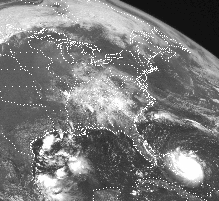 |
 |
 |
 |
 |
 |
 |
 |
 |
 |
 |
 |
 |
 |
 |
 |
 |
 |
 |
 |
 |
 |
 |
 |
 |
 |
 |
 |
 |
 |
 |
 |
 |
 |
 |
 |
 |
 |
 |
 |
 |
 |
 |
 |
 |
 |
 |
 |
 |
 |
 |
|
|
 |
|
|
|
 |
|
|
|
 |
|
|
|
 |
|
|
|
Each of the four cases examined in this text represented several examples of the kinds of major disasters emergency managers might face.
Case#1, the World Trade Center Bombing, was an example of terrorism and sabatoge.
Case#2, the Chicago Flood, was an example of what happens when human neglect continues until a "worst case" scenario occurs.
Case#3, Hurricane Andrew, was a natural disaster of huge magnitude where wind caused the majority of damage compounded by high tides and storm surge.
Case#4, the Great Flood of 1993, was also a natural disaster where water was a major cause of damage, but also an example of what happens when confusion and uncertainty exits about who is responsible for the maintanance of dikes and levies, and at what specification levels. |
|
|
|
In all 4 cases, there were key issues which contributed toward the disaster impact. These include:
1) inadequate backup systems; |
|
|
|
2) human error and neglect; |
|
|
| 3) difficulties in damage assessment; |
|
|
| 4) miscommunication; |
|
|
| 5) the lack of adequate public education; |
|
|
| 6) the need for improved technology; |
|
|
| 7) the need to establish standards; |
|
|
| 8) inadequately trained emergency management staff; |
|
|
| 9) the need to establish media (broadcasting) cooperation; and |
|
|
10) the need to develop better models to aid in prediction of disasters.
The next few paragraphs will give a summary of where these issues specifically occured in each of the cases discussed |
|
|
|
BACKUP SYSTEMS: |
|
|
|
When the World Trade Center was bombed there were no proven secure backup systems in the building for utilities feeding into the building structure. The primary and backup power supply systems were extremely vulnerable to the bomb blast, and were subsequently shut off completely when exposed to water from sprinklers. During the Chicago Flood, there was no backup emergency power in case of a total grid failure. During Hurricane Andrew, the power distribution grid actually did fail. Because no power backups existed, whole infrastructures which were dependant on electricity became paralyzed. During the Great Flood of 1993, there was a disruption of rail; highway; and transportaion infrastructures, as well as total power failures in many areas, due to both insufficient or non-existent backup systems. |
|
|
|
HUMAN ERROR AND NEGLECT: |
|
|
|
Prior to the bombing of the World Trade Center, an anti-terrorism task force had recommended over 170 safety improvements. These were ignored by the NY-NJ Port Authority, because of the high estimated costs for implementation. After the Chicago Flood, the breach in the river wall was traced back to a combination of inspector neglect and contractor liability. The contractor used shoddy materials and poor construction techniques. The inspector of the tunnel system failed to make a critically scheduled inspection because he said he could not find a parking space. Then change orders were signed even though the inspection had not been made. In addition, 3 months prior to the flood, a small breach in the tunnel wall was reported but tragically ignored by authorities. In the aftermath of Hurricane Andrew, many homes were found not to be in compliance with the Southern Florida building codes, due mainly to contractor fraud. Most of these homes had poorly constructed doors, windows and roofs, and more shockingly, were constructed using industrial staples rather that the usual nails. Lax building code enforcement by public officials was responsible for housing that passed inspection which rightfully never should have. Lastly, during the Great Flood of 1993, privately owned levees were often not built up to Army Corp standards, which contributed to the 70% failure rate. |
|
|
| DAMAGE ASSESSMENT: |
|
|
| No true advance recovery plan existed at the World Trade Center until after the bombing incident. The NY-NJ Port Authority needed to hire outside independant contractors to make those assessments. During the Chicago Flood, there was no emergency managment staff consensus regarding assessment activities and safety related matters. Agency and federal agents experienced confusion during Hurricane Andrew in regards to who owned certain jurisdictions and what were the realms of authority. This often led to inaction instead of the desperately needed assessment activities. During the Great Flood of 1993, data exchange problems occurred between agencies, because of the lack in forms and software standards, which led to redundant data gathering activities and confusion as to whom to give data to for eventual dissemination. Emergency management at the time also lacked provisions to access damage and the needs of disaster victims. |
|
|
| COMMUNICATION PROBLEMS: |
|
|
| After the World Trade Center Bombing, the NY-NJ Port Authority and their agents experienced confusion due to authority issues regarding delegation of tasks to subcontractors. Telecommunication vehicles were disrupted for awhile in parts of that building. During the Chicago Flood incident, Chicago utility providers needed to better coordinate their emergency planning with agency authorities. For example, there was no staff concensus on emergency related matters. |
|
|
|
During Hurricane Andrew, emergency management teams experienced feelings of insecurity while trying to determine authority channels for particular projects. In addition, telecommunications systems experienced breakdown due to the storm. But luckily, some of the fiber glass conductors underground were undamaged, so much of the computer and telephone communication was not affected. The Great Flood of 1993 revealed problems in data exchange between agencies. Due to structural damage, much of the telecommunications infrastructure was disrupted. It was observed that there needed to be a better backup for telecommunications systems. Communication between agencies needed to improve drastically. |
|
|
|
PUBLIC EDUCATION: |
|
|
|
In all four cases, emergency mangers commented that there needed to be more training sessions to inform the public of emergency procedures and policies. It was also found that published materials on emergency related issues tended to be insufficient for population needs. There also tended to be inadequate dissemination of those emergency related materials to the public. |
|
|
|
TECHNOLOGY ISSUES: |
|
|
|
In all four cases, technologically related deficiences were found within the current forecast warning systems. Available computer systems were usually inadequate for system needs. Agents and key personnel were often under- informed as to the capabilities of their computer systems and appropriate software packages. Data was not being archived properly in easily accessible digital format, because personnel were still chained to a "paper" system mentality. |
|
|
|
STANDARDS: |
|
|
|
Standards in software were often lacking between agencies and federal departments. Computer systems needed to be updated to handle new modules of software and large capacity databases. Many systems needed to create better prediction tools and new system models. In all four cases, the lack of standards made dissemination of information between agencies and Federal departments difficult. Standards on forms, storm data collection, etc. would have made access to information through automation easier to use and more efficient. |
|
|
|
STAFF TRAINING: |
|
|
|
In all four cases there were problems with overall emergency management staff training. In the World Trade Center Bombing case, there were no trained personnel practiced in emergency procedures. In the Chicago Flood case, key personnel were found to be unfamiliar with contracting procedures and key computer software. In both the Hurricane Andrew and Great Flood cases, there was a lack of adequate emergency management training at the state and local levels. |
|
|
|
MEDIA COOPERATION: |
|
|
|
In all four cases, there needed to be better notification of media sources and better efforts at cooperation with the media. |
|
|
|
DISASTER PREDICTION: |
|
|
|
There need to be better tools created and newer models to aid prediction. Staff should be rained more intensely in how to handle appropriate prediction software. |
|
|
|
 |
|
|
| The next section of this paper will give this author's final thoughts and recommendations in regards to the National Information Infrastructure emergency management system. |
|
|
|
 |
|
|
|
|
|
(Updated 9/01/03 D.J. Russell) |
|
|
|
|
 |
|
|
|
|

|
|
|
|
|
 |
|
|
|
|
|
|
 |
|
|
|



